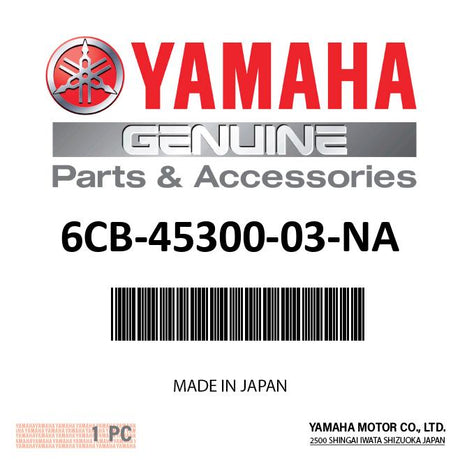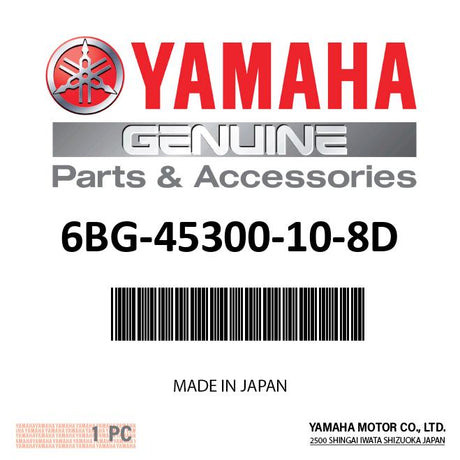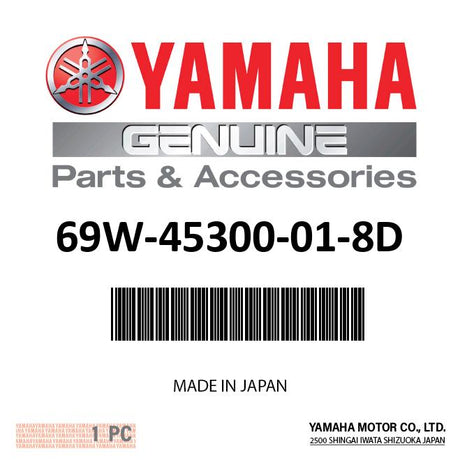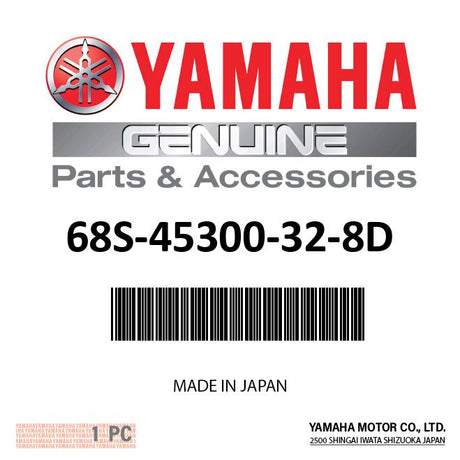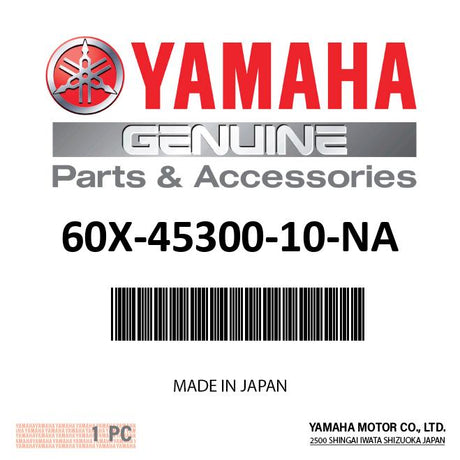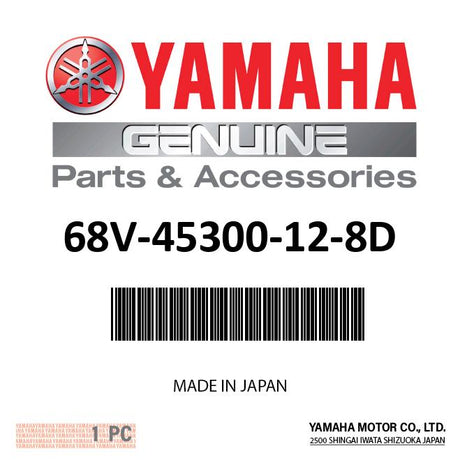Our complete selection of Yamaha outboard lower unit assemblies, prop shafts, and transmission components are intended to replace your old or broken Yamaha outboard parts.
We also hope to regularly publish helpful resources to help you maintain your Yamaha outboard motor, such as:
Replace or repair your Yamaha lower unit assembly, prop shaft, and transmission components with boat engine parts from PartsVu.
Yamaha Outboard Lower Unit Assemblies, Prop Shafts, and Transmission Components FAQs
What is the lower unit on a boat?
The lower unit, also known as the gearcase, is a vital component of an outboard motor on a boat. It is responsible for transmitting the power from the engine to the propeller, which propels the boat through the water.
The lower unit is located below the engine and consists of several parts, including the drive shaft, gear set, bearings, seals, water pump, and propeller shaft. The lower unit is typically submerged in water, and its housing is designed to prevent water from entering the engine compartment.
What is a lower unit on a boat used for when you’re out on the water?
Essentially, the lower unit is essential for controlling the direction and speed of the boat, as well as for maneuvering in tight spaces or around obstacles.
What is a Yamaha outboard lower unit assembly?
Also commonly called a gearcase, an outboard lower unit assembly transfers the rotational energy from the outboard engine and transfers it to the propeller, causing it to rotate and move the boat. The lower unit houses several essential components, without which your boat couldn’t move through the water.
Yamaha lower unit gear lube is drained by removing the lower drain screw first and then the upper plug vent to allow air in. On most models, both plugs are clearly visible on the lower unit, but on models with low water pickups, the forward pickup will need to be removed to access the drain plug. Use a properly sized screwdriver assisted by a wrench if necessary to loosen these screws which should be pretty tight. An impact driver and hammer may be needed depending on who serviced your engine last. The drain screw has a magnetic tip, so inspect the plug after removal to see if heavy deposits exist. Some fine shavings are normal, but chunks or a large quantity of metal is cause for further inspection. Have a drain pan and extra rags handy as gear lube will begin running down the skeg as soon as you remove the upper vent plug. Be sure to collect the fiber gaskets from both plugs after removal, as these are not reusable and should be discarded.
Allow several minutes with the engine tilted all the way down to fully drain the old gear oil. Like your engine oil, inspect the spent oil for evidence of water intrusion or other contamination or metal. If you have purchased one of PartsVu’s handy lower unit oil change kits you will already have new gaskets, oil, and a pump. Screw the pump into the lower drain hole and then connect it to the quart of Yamalube gear oil or HD gear oil depending on your model. Begin pumping oil into the lower unit until oil begins to flow from the vent plug at the top. Stop pumping and wait a few minutes for all the air bubbles to work themselves out of the gearcase. After this brief pause, pump a few more pumps until clean gear oil without bubbles is flowing from the vent plug. With a fresh fiber gasket in place, install and torque the top vent plug. Unscrew your fill hose from the lower drain plug and quickly swap in the lower drain plug with a new gasket. Torque to spec and re-install the lower water pickup screen if applicable.
How do I perform a visual check on my Yamaha outboard lower unit?
Visually inspect the exterior of your lower unit for any signs of damage every time before you go out. If you fish, it’s a good idea, every fifty hours or so (or when necessary whichever occurs first), to remove the propeller and check for any fishing line or other debris that may be wrapped around the propeller shaft, which can cut into prop shaft seals and potentially allow water to enter the gearcase. If found, visually inspect the prop shaft seals for damage or leakage. Then check the color of your lower unit lubricant by cracking the “drain screw” on the bottom of the bullet and the “vent screw” on the side of the lower unit. Allow a small amount to drain into a clean container. If the lubricant is milky in color, you’ve got water in the lubricant. Have the lower unit seals inspected by your Yamaha Marine dealer through a pressure test, and if necessary, have the seals replaced. Pressure testing a lower unit is best performed by an authorized Yamaha Marine dealer, because depending on findings, it may be necessary to disassemble the lower unit for further inspection.
Since you, company are in the neighborhood – take the opportunity to lube your prop shaft, bearings, and any other wear points – Yamalube Marine Grease is good – use it!
How to change outboard gear oil?
How to change lower unit oil?
How do I change the gear oil in my Yamaha outboard motor?
To change the gear oil in your Yamaha outboard motor, start by removing the drain plug from the lower unit and allowing the oil to drain out completely. Then, refill the gear case with fresh gear oil, taking care not to overfill it. Finally, replace the drain plug and wipe up any excess oil.
To do it yourself, place a pan under the bottom drain screw, remove the screw, and then remove the upper vent screw on the side of the lower unit. Allow all of the lubricant to drain into the pan. While you’re waiting, check the drain screw. It’s magnetic, so any metal particles or shavings present in the lubricant will be attracted to it. Fine metallic dust is normal, but if you find larger chips of metal on the screw or in the pan as the lubricant drains, have your local Yamaha Marine dealer check for possible internal damage. Also at this time, replace the small crush washer present on each screw (commonly known as “drain plug gaskets”). If you don’t see one, it may still be adhering to the outboard. Use a pick to pull it free, as these must be located, discarded, and replaced each time these screws are removed.
Once all the lube has drained, refill the lower unit by threading the appropriate fitting into the lower unit drain screw opening (on the bottom of the bullet) and slowly pumping in fresh Yamalube Marine Gearcase Lube or Lubricant HD. Once you see this new fluid seeping out of the upper vent screw hole, stop and wait 5 minutes, then very slowly continue pumping until it seeps from the vent screw again. At this point, replace the vent screw with a new crush washer installed, and tighten it according to manufacturer specifications. Remove the fitting attached to the drain screw opening, and quickly re-install the drain screw with the new crush washer installed. Tighten to factory specifications.
You may choose to do these procedures yourself, or you can have your authorized Yamaha Marine dealer do them for you. Either way, performing them is important for proper continued operation and your continued satisfaction and enjoyment.
What are the signs of water in lower unit of Yamaha outboard?
Water in the lower unit of a Yamaha outboard can cause damage to the engine if not addressed promptly. Here are some signs that may indicate the presence of water in the lower unit:
-
Milky or cloudy lower unit oil: Check the color and consistency of the lower unit oil by removing the drain plug and inspecting the oil on a clean, white cloth. If the oil appears milky or cloudy, it may contain water.
-
Abnormal noise or vibration: Water in the lower unit can cause abnormal noise or vibration when the engine is running, as well as reduced performance and acceleration.
-
Overheating: Water in the lower unit can also cause the engine to overheat, as the water can interfere with the cooling system.
-
Corrosion: Water can cause corrosion and rust inside the lower unit, which can lead to damage and decreased performance over time.
If you suspect that there is water in the lower unit of your Yamaha outboard, it is important to have it inspected by a qualified marine technician as soon as possible. They can drain the oil and inspect the lower unit for damage or corrosion, and replace any damaged parts as necessary. It is also recommended to check the lower unit oil regularly and change it at the recommended intervals to help prevent water contamination.
What should I know about remanufactured outboard lower units?
Remanufactured outboard lower units are a cost-effective alternative to purchasing and shipping a brand new unit. Here are some things you should know about remanufactured outboard lower units:
-
Quality: Remanufactured outboard lower units are typically disassembled, inspected, and rebuilt using high-quality replacement parts to meet or exceed OEM specifications. This ensures that the unit is reliable and performs as intended.
-
Cost savings: Remanufactured outboard lower units are typically less expensive than purchasing a brand new unit, which can provide a significant cost savings to boat owners.
-
Warranty: Many remanufactured outboard lower units come with a warranty, which provides additional peace of mind for boat owners.
-
Compatibility: It is important to ensure that the remanufactured outboard lower unit is compatible with your specific make and model of outboard motor. This may require verifying the part number and consulting with a qualified marine technician.
-
Installation: Remanufactured outboard lower units may require installation by a qualified marine technician, as they can be complex and require specialized tools and knowledge.
-
Maintenance: Proper maintenance is essential to ensure the longevity and performance of a remanufactured outboard lower unit. This may include regular oil changes, inspections, and preventative maintenance to address any issues before they become more serious.
Overall, remanufactured outboard lower units can be a cost-effective and reliable option for boat owners who need to replace a damaged or worn mercury outboard bottom unit. However, it is important to do your research, ensure compatibility, buy used and work with a qualified marine technician to ensure proper installation and maintenance.
What is the cost to rebuild an outboard lower unit?
The cost to rebuild outboard lower unit can vary depending on several factors, such as the make and model of the outboard motor, the extent of the damage, and the cost of shipping the replacement parts.
On average, the cost of rebuilding an outboard lower unit can range from $500 to $1,500 or more. This cost may include labor charges, replacement parts such as bearings, gears, seals, and gaskets, and the cost of any special tools required to complete the repair for Yamaha outboard lower units.
It is important to note that the cost to rebuild lower unit can be lower than the cost of replacing it with a brand new one. However, the decision to rebuild or replace the lower unit should be made after a thorough inspection and evaluation of the damage by a qualified marine mechanic.
How often to change lower unit oil?
The frequency of changing the lower unit oil in an outboard motor can vary depending on several factors, such as the type and brand of oil used, the age and condition of the engine, and the frequency of use.
As a general guideline, it is recommended to change the lower unit oil at least once a year or every 100 hours of use, whichever comes first. However, if the engine is used in harsh conditions, such as saltwater or dusty environments, or if it is used frequently, it may be necessary to change the oil more often.
It is important to follow the manufacturer's recommendations for the type of oil to use and the frequency of oil changes, as these guidelines are specific to each engine model and are designed to help maintain the engine's optimal performance and longevity.
In addition to changing the oil, it is also recommended to inspect the lower unit oil regularly for signs of water contamination, debris, or other issues that may require maintenance or repairs.
What's the difference between a Yamaha 4 stroke lower unit and a Yamaha 2 stroke lower unit?
The main difference between a Yamaha 4-stroke lower unit and a Yamaha 2-stroke lower unit is in their design and operation.
Yamaha 4-stroke outboard motors use a four-stroke combustion cycle, which means that they have a separate intake, compression, combustion, and exhaust stroke. This type of engine is generally quieter, more fuel-efficient, and produces less emissions than a 2-stroke engine. The lower unit on a Yamaha 4-stroke outboard is typically designed to handle the lower RPMs and torque produced by the engine.
On the other hand, Yamaha 2-stroke outboard motors use a two-stroke combustion cycle, which means that they have a combined intake and compression stroke, followed by a combined combustion and exhaust stroke. 2-stroke engines are generally simpler in design and produce more power for their size than 4-stroke engines, but they also tend to be louder and less fuel-efficient. The lower unit on a Yamaha 2-stroke outboard is typically designed to handle the higher RPMs and power output of the engine.
In terms of maintenance, the lower units on Yamaha 4-stroke and 2-stroke outboards may require different types of oil and have different oil change intervals, as well as different gear ratios and propeller shaft sizes. It is important to consult the manufacturer's recommendations and specifications for each specific engine model when performing maintenance or repairs on the lower unit.
How much lower unit oil for Yamaha 150?
The amount of lower unit oil required for a Yamaha 150 outboard motor can vary depending on the model year and whether the engine has a standard gear ratio or high-performance gearcase.
As a general guideline, a Yamaha F150 outboard motor with a standard gearcase typically requires approximately 1.3 quarts (1.2 liters) of lower unit oil. A high-performance gearcase may require slightly more oil, up to 1.5 quarts (1.4 liters).
It is important to refer to the owner's manual or service manual for the specific model year and gearcase type to determine the exact amount of oil required. It is also recommended to use the manufacturer's recommended oil type and viscosity for optimal performance and protection of the lower unit.
What does a Yamaha outboard lower unit oil change kit typically include?
A Yamaha outboard lower unit oil change kit typically includes the following items:
-
Lower unit oil - The kit usually includes enough Yamalube lower unit oil to complete the oil change. The amount of oil required can vary depending on the engine model and year.
-
Drain plug gasket - The kit usually includes a new Yamaha outboard lower unit drain plug gasket to replace the old one. This helps to ensure a tight seal and prevent leaks.
-
Fill plug gasket - The kit may also include a new fill plug gasket, although this is not always necessary to replace during an oil change (however it’s a good best-practice while you’re servicing your Yamaha out board).
-
Oil extractor pump - Some kits may include an oil extractor pump, which is a device used to extract the old oil from the lower unit. This can be a helpful tool to have, as it makes the oil change process quicker and easier.
-
Funnel - A funnel is often included to help pour the new oil into the lower unit without spilling.
-
Instructions - The kit may come with instructions or a guide on how to perform the oil change correctly and efficiently.
How much lower unit oil do I need?
The amount of lower unit oil you need will depend on the specific model and size of your outboard engine. You can consult your owner's manual or contact a Yamaha dealer for information on the appropriate amount of oil to use.
How to install a Yamaha lower unit?
Installing a Yamaha lower unit requires removing the old unit, aligning the new unit with the driveshaft, and tightening the mounting bolts. It is recommended to seek professional help from a Yamaha dealer for this procedure.
What kind of lower unit oil for Yamaha?
Yamaha recommends using their Yamalube gear oil for their outboard engines. However, there are other gear oil brands that are compatible with Yamaha outboards. It is important to consult your owner's manual for the recommended oil type.
What is a lower unit on an outboard?
The lower unit on an outboard engine is a housing that contains the gears and other mechanical components responsible for transferring power from the engine to the propeller. It is located below the engine and is typically submerged in water.
How to check lower unit oil in Yamaha outboard?
To check the lower unit oil in your Yamaha outboard, remove the oil level screw and check the oil level. The oil level should be even with the bottom of the oil level screw hole. If the level is low, add more oil until it reaches the correct level.
How often to change gear oil in outboard motor?
It is recommended to change the gear oil in your outboard motor every 100 hours of operation or at least once a year, whichever comes first. However, it is important to check your owner's manual for specific recommendations for your engine model.
Lower unit rebuild cost and replacement cost?
The cost of a lower unit rebuild or replacement will vary depending on the model and size of your outboard engine, as well as the extent of the damage or wear to the existing lower unit. It is recommended to seek professional help from a Yamaha dealer for an accurate estimate.
Changing seals in lower unit on a Yamaha outboard and Yamaha outboard gearbox removal?
Replacing seals in the lower unit on a Yamaha outboard or removing the gearbox requires specialized knowledge and tools. It is recommended to seek professional help from a Yamaha dealer for these procedures.
What are some other names for Yamaha lower unit oil?
Yamalube is the primary brand of lower unit oil recommended by Yamaha for their outboard motors. However, some other names or brands of lower unit oil may be used interchangeably or as alternatives to Yamalube, depending on the specific requirements of the engine. Some of these names include:
-
Marine gear oil
-
Lower unit lubricant
-
Lower unit oil
-
Outboard gear oil
-
Yamaha gearcase oil
It is important to check the manufacturer's recommendations and specifications for oil type and viscosity to ensure that the correct oil is used for optimal engine performance and longevity.
What is a lower unit on an outboard motor?
The lower unit on an outboard motor is the part of the motor that sits below the waterline and houses the outdrive motor's gears, driveshaft, and propeller. It is responsible for transferring power from the motor to the water, propelling the boat forward.
Yamalube HD gear oil is a high-performance lubricant designed specifically for use in the lower units of Yamaha outboard motors. It is formulated to provide superior protection against wear, corrosion, and heat buildup in high-performance marine environments.
Can I use aftermarket lower units on my outboard motor?
Yes, it is possible to use aftermarket lower units on your outboard motor. However, it is important to ensure that the aftermarket lower unit works, is compatible with your specific motor make and model, and that it meets the manufacturer's recommended specifications.
What is Yamaha gear case oil?
Yamaha gear case oil is a specialized lubricant formulated for use in the gear case of Yamaha outboard motors. It is designed to provide superior protection against wear and corrosion, and to extend the life of the gears and bearings in the gear case.
What is Yamalube outboard gear oil?
Yamalube outboard gear oil is a high-performance lubricant designed specifically for use in the gear case of Yamaha outboard motors. It is formulated to provide superior protection against wear and corrosion, and to extend the life of the gears and bearings in the gear case.
What type of oil should I use in my Yamaha 250 SHO lower unit?
For best results, Yamaha recommends using Yamalube marine gear lube in the lower unit of your Yamaha 250 SHO outboard motor.
Where can I find a Yamaha 150 TRP lower unit for sale?
You can find stock Yamaha 150 TRP lower units for sale at authorized Yamaha outboard dealerships, as well as online marine parts retailers.
What is Yamalube gearcase lube HD?
Yamalube gearcase lube HD is a high-performance lubricant designed specifically for use in the gear case of Yamaha outboard motors. It is formulated to provide superior protection against wear and corrosion in high-performance marine environments.
How much does it cost to rebuild a lower unit?
The cost of rebuilding a lower unit can vary widely depending on the make and model of your outboard motor, as well as the extent of the damage to the lower unit. It is best to consult with a certified marine technician or outboard dealer for an accurate estimate.
What type of oil should I use in my Yamaha F200 lower unit?
For best results, Yamaha recommends using Yamalube marine gear lube in the lower unit of your Yamaha F200 outboard motor.
What is lower unit lubricant?
Lower unit lubricant is a specialized oil or lower unit grease used to lubricate the gears and bearings in the lower unit of an outboard motor. It is designed to provide superior protection against wear, corrosion, and heat buildup in high-performance marine environments.
What is a lower unit drain screw?
A lower unit drain screw is a small plug or screw located on the bottom of the lower unit of an outboard motor. It is used to drain the old







